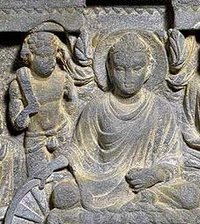Vajrapani
|
|
| Missing image Dharma_wheel_1.png Dharma wheel Buddhism |
| Culture |
| History |
| List of topics |
| People |
| By region and country |
| Schools and sects |
| Temples |
| Terms and concepts |
| Texts |
| Timeline |
Vajrapani (Sanskrit Vajra:thunderbolt/diamond, Pani:lit.in the hand) is one of the earliest bodhisattvas of Mahayana Buddhism. He is the protector and guide of the Buddha, and rose to symbolize the Buddha's power.
Vayrapani was used extensively in Buddhist iconography as one of the three protective deities surrounding the Buddha. Each of them symbolizes one of the Buddha's virtues:Manjusri (the manifestation of all the Buddhas' wisdom),Avalokitesvara (the manifestation of all the Buddhas' compassion) and Vajrapani (the manifestation of all the Buddhas' power).
Iconography
The first representations of Vajrapani in India associated him with the Hindu God Indra.
As Buddhism expanded in Central Asia, and fused with Hellenistic influences into Greco-Buddhism, the Greek god Hercules was adopted to represent Vajrapani. He was then typically depicted as a hairy, muscular athlete, wielding a short "diamond" club.
Mahayana Buddhism then further spread to China, Korea and Japan from the 6th century.
In Japan, Vajrapani is known as Shukongōshin (執金剛神, "Diamond rod-wielding God"), and has been the inspiration for the Niō (仁王, lit. Benevolent kings),the wrath-filled and muscular guardian god of the Buddha, standing today at the entrance of many Buddhist temples under the appearance of frightening wrestler-like statues.
External links
- Images of Shukongōshin in Japan (http://images.google.co.jp/images?q=%E5%9F%B7%E9%87%91%E5%89%9B%E7%A5%9E&hl=ja&lr=&ie=UTF-8&sa=N&tab=wi)

